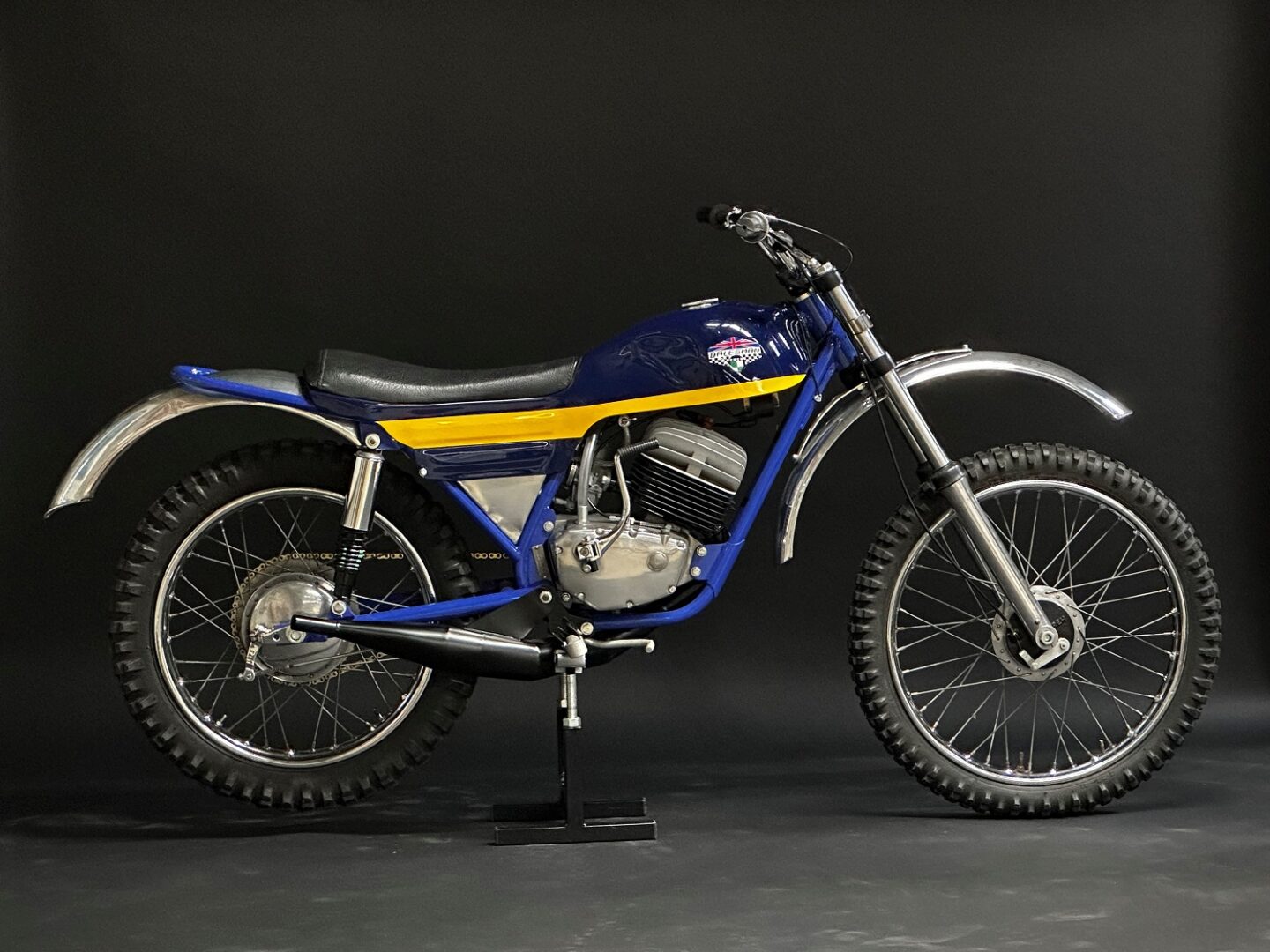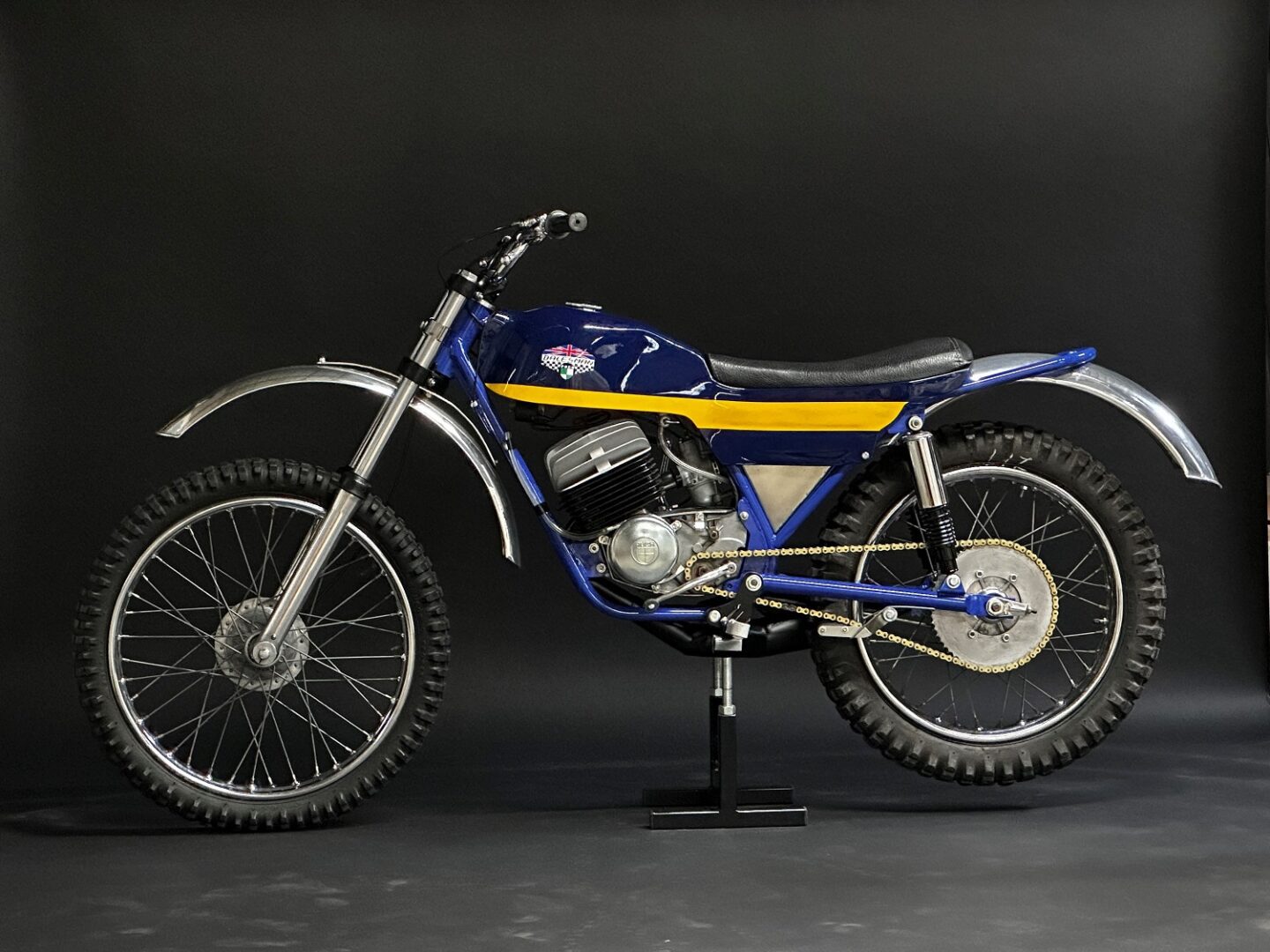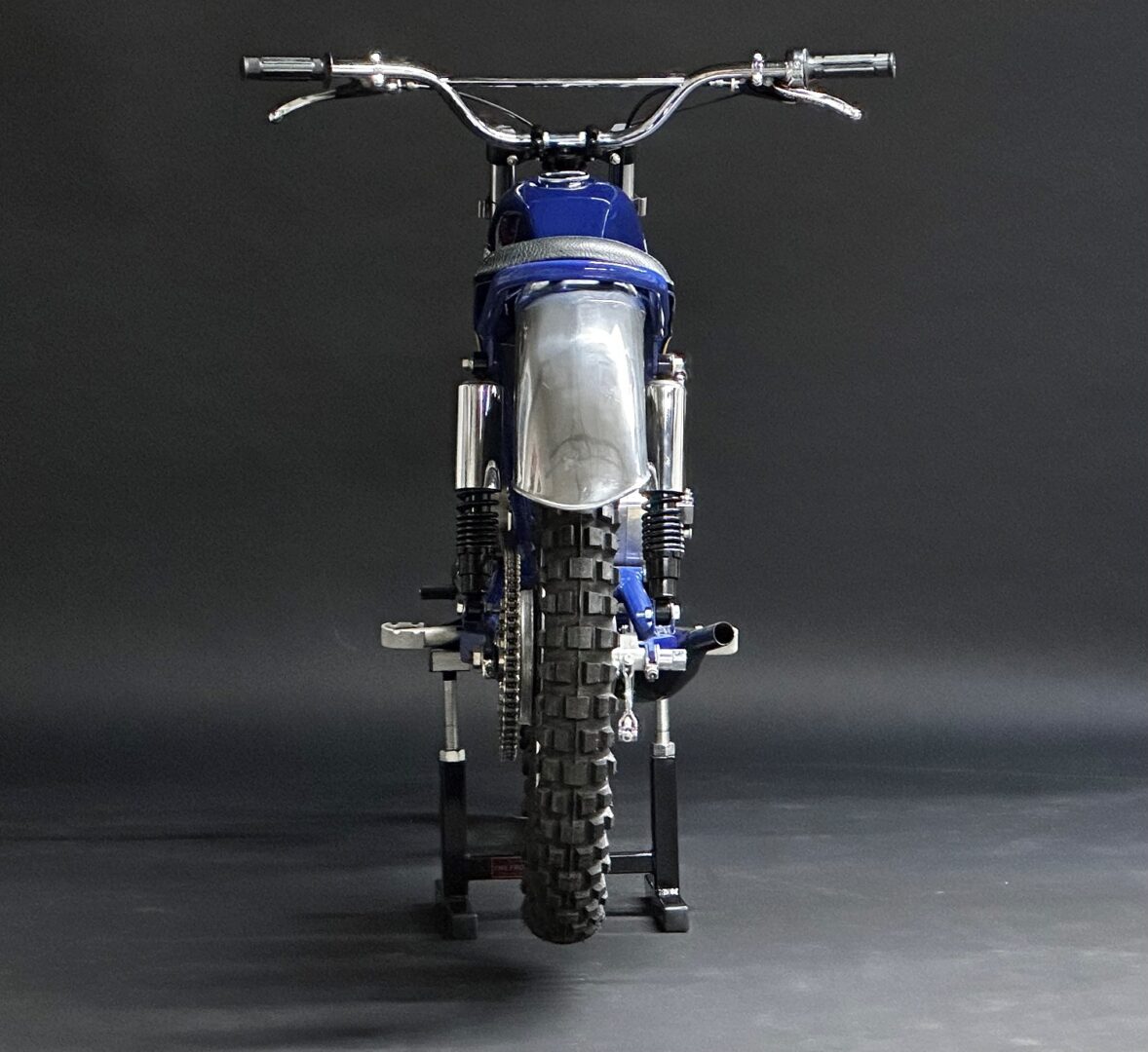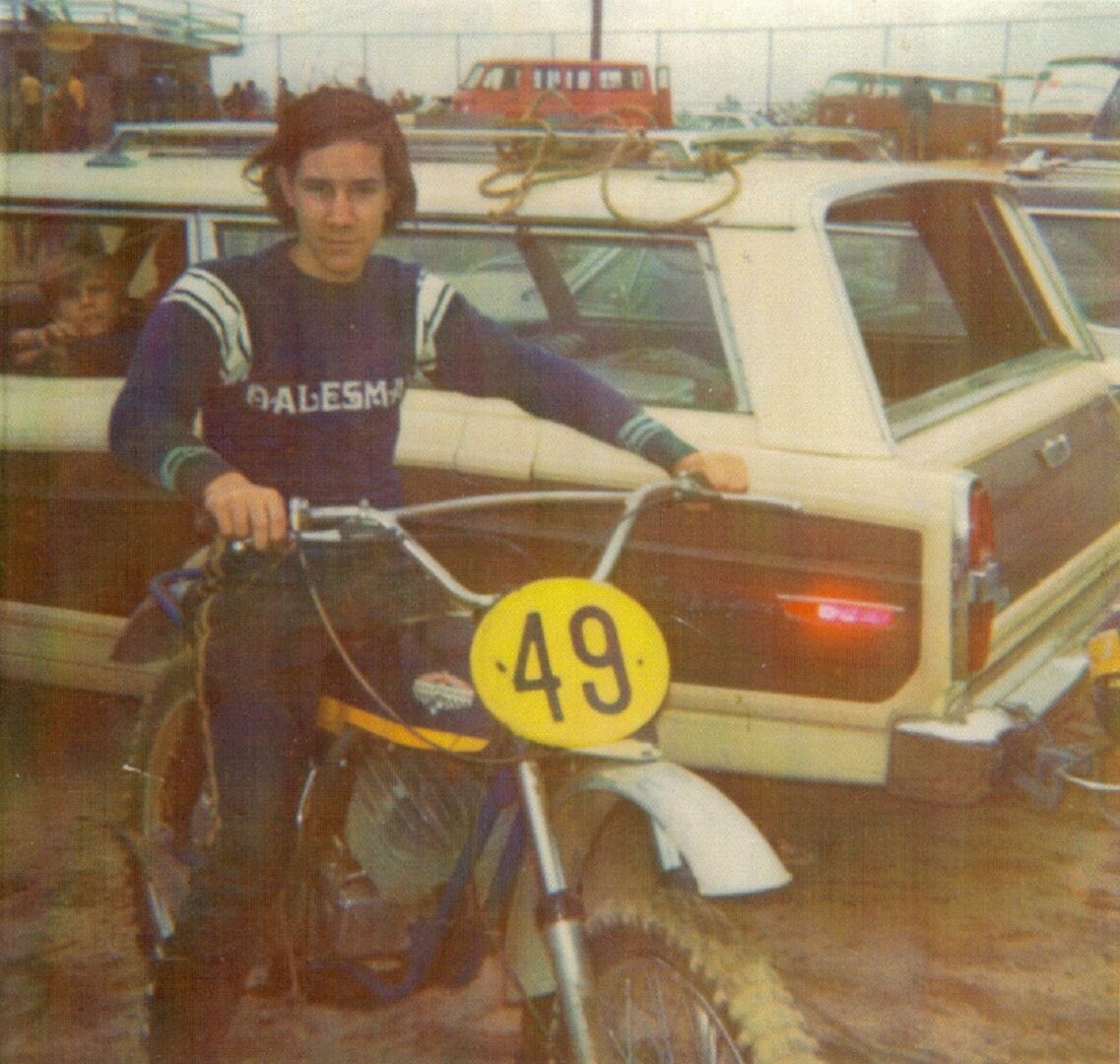1971 Dalesman 125 Moto-Cross
Model Information
Company History:
In 1966 Peter Edmondson owned Otley Cycle & Motorcycle Depot in Otley, West Yorkshire, England. They sold bicycles and were also a Greeves and BSA motorcycle dealership. As an entrepreneur and trials rider, in 1967 Edmondson walked into the UK importer of Steyr-Puch products and saw the new Puch M125, a proven road racing bike and suggested that it could potentially be modified into a competitive 125 trials bike.
Edmondson purchased the M125 on the spot, brought it back to his shop and began converting into a trials bike. When he had what he felt was a competitive bike, he brought it to Steyr-Daimler-Puch in Graz, Austria. Although impressed, they weren’t confident they could compete with the Spanish brands that dominated the market and wouldn’t commit to building a Puch trials bike. Edmondson then asked if he could purchase Puch engines and build his own brand of trials bikes. Puch agreed and would supply Edmondson a complete 125 engine including a carburetor and ignition.
In 1968 Edmondson sold Otley Cycle & Motorcycle Depot, launched Dalesman Competition Limited and production of the trials bike began (I haven’t been able to determine why he named the company/bike “Dalesman”). Saving on start-up costs wherever he could, Edmondson employed his neighbors to help with assembly and even had some components manufactured at the local prison. He started distribution by getting a few Puch dealers to carry his new Dalesman 125 Trials bike. In 1969 Puch invited Edmondson to their headquarters to attend one of Joel Robert’s training schools (presumably scrambles/motocross) held near Graz, Austria. That visit was enough to inspire him to begin the development of 125 Enduro and 125 Moto-cross models and bring on Joel Robert to assist. (Note: I’m not sure what Joel Robert’s association with Puch was at this time as he was a factory CZ rider).
According to Cycle magazine, development of the 125 Moto-cross model was finalized during the winter of 1969. At about the same time, having just acquired the Greeves motorcycle franchise for the Eastern US, while still in England Ron Jeckel negotiated a deal with Edmondson for the Dalesman franchise for the US. In 1970 the Dalesman 125 Moto-Cross and 125 Enduro models went into production and began exporting to the official US importer Jeckel Industries of Glens Falls, NY owned by Ron Jeckel, a successful US businessman and east coast enduro rider. According to Motor Cycle magazine (an English newspaper), in 1971 at age 34, Ron Jeckel convinced Edmondson to allow him to invest in Dalesman to increase production (currently at 15/20 bikes per month) to keep up with demand in the American market. Edmondson was now no longer sole owner of Dalesman. I don’t know if Ron Jeckel was the sole investor or if there was an investor group. By now over 95% of the bikes were being shipped to America, mostly by ship until the US longshoreman strike, which forced Dalesman to ship by air. Jeckel increased staff from 2 to 14 increasing production to 120 – 130 bikes per month. Apparently Jeckel was an excellent enduro rider as he and Chuck Boehler won the silver medal in the 1971 ISDT Six Day in the Isle of Man riding the Dalesman 125 Enduro. Decades later, Edmondson’s son Peter went on to become a four-time World Enduro Champion.
Apparently, at some point differences arose and my understanding is the board forced Edmondson out of Dalesman, with Jeckel now being the majority shareholder. With American sales declining (possibly due to competition) and an unfavorable US exchange rate, Dalesman production ended in 1974. It’s estimated that approximately 2000 Dalesman motorcycles were produced during their 6-year run with the majority being exported to Jeckel Industries. Edmondson went on to join motorcycle parts manufacturer Wassel Motorcycles to help them develop their own brand of 125 Motocross and 125 Trials bikes. Penton private labeled the Wassell 125 Trials bike and rebranded it as the Penton Mudlark to add a trials bike to their lineup. However, as with Dalesman, competition and the falling dollar forced Wassell to end production in 1975.
The Bike:
The first year Dalesman 125 Moto-cross launched in 1970 and they continued to produce the model in 1971, 1972 and 1973. Although production ceased in 1974, it’s possible some bikes were sold in 1974 but they were likely left over 1973 models.
To my knowledge, there were only two magazine tests of the Dalesman 125 Moto-cross and both were of the 1970 model; the November 1970 issue of Cycle World and the October 1970 issue of Cycle. Because this was the only published feedback, I decided to start with the description of the 1970 model. The 1970 model utilized a 4-speed two stroke Puch engine with a 24mm Bing carb and a Bosch magneto ignition. Although the sales brochure stated “Moto-cross gear-head ratios” (whatever that means), the Cycle World test stated that there was a grotesque gap between first and second gears. The same test also stated that the kick starter consistently rubbed against your right leg in any riding position.
The frame was built of Reynolds 531 tubing and had a 52.5” wheelbase with 21” front and 18” rear wheels with Dunlop Sports knobby tires. The hubs and front forks (with a reported 6” of travel) were produced by the English brand REH (Robert E. Humphries). The rear shocks were 11.75” Girlings. The Cycle World test stated that despite the forks not functioning well, clanking loudly when they topped out, the handling was better than average (the bar was pretty low at the time).
The tank, side panels and front number plate were alloy and the handlebar width was 35.5”, with the intention that the rider would cut them down to suit their personal preference. The bike was feather light at 170 pounds with a US MSRP of $750, which was in line with the Bultaco Sherpa ($749) and the Montesa Cappra ($766) of the same year. Cycle World concluded by stating “The bike needs some race readying. But the raw material is there.”
The changes for the 1971 Dalesman 125 Moto-cross featured here were significant. A new frame was Perry Winkle blue in color with an increase in wheelbase length of ½” and ground clearance of 2”. The most striking change was a single piece fiberglass tank and seat base design painted in royal blue and yellow. The thin vinyl covered seat gave the bike a sleek appearance. The whole assembly was held together by a single bolt through the rear alloy fender and a bungee cord anchoring the front of the tank. The fuel tank utilized fuel petcocks on each side of the tank. In a magazine test of the 1971 Dalesman Enduro (which utilized the same seat), there were complaints of the seat being too soft. Interestingly, the Enduro also had a built-in chain oiler fed by a 1.5 pint reservoir in the top frame tube.
In terms of performance, the biggest change for 1971 was an upgraded 6-speed Puch engine and a 30mm Amal carb, increasing the horsepower to 18.5. Possibly it was due to the new frame or possibly through testing, they decided to switch to a 3.50” x 19” rear tire. Somehow the bike also gained 15 pounds, now weighing 185 lbs according to their literature.
Although there weren’t any magazine tests on the ’71 model, we can provide some real-world insight from Larry Hladki (more on him in the Provenance section) who in 1971, at age 16 raced a 1971 Dalesman 125 Moto-cross. Larry remembers it like this: “In 1970 I was 15 years old racing a Yamaha AT-1 MX. I was obsessed with the exploding sport of MX. I rode my Schwinn to the magazine store almost every day to see if there were any new motorcycle magazines. During that time there were new brands and models coming out all the time. When Dalesman information started popping up in 1970, I was interested . There was a dealer within my area (Two Cycle Project) and he was enthusiastic about putting me on one. I tried a 1970 and it handled well but the four-speed gearbox was a big hindrance. Soon after that he received the first 71. It had everything: six speed, fiberglass tank/seat combo, radial head, conical hub and down pipe. I test rode it and that was it, my next race bike.
As far as the actual performance of the bike, it was very light, had good power and shifted excellent. The suspension was good and I thought it handled great. My riding buddies had a Rickman Zundapp, Bultaco Sherpa S and a Puch MC125. The Dalesman wasn’t as fast as the Bultaco, but it was quite a bit lighter. I didn’t like the handling of the Bultaco, it felt too stretched out. The Rickman was great; excellent handling and better suspension but it wasn’t as fast as the Dalesman. The Puch was really well built and handled well, but it weighed a lot more with the same power. There were many other 125’s available then, some were good, some not so. I won many races on my Dalesman. It never gave me any reliability problems and I still think it’s one of the best-looking bikes.”
The 1972 model received minor improvements. The frame color was switched to Hammerite silver, the yellow stripe on the tank was changed slightly, and the Union Jack Dalesman logo on the tank was now just the name Dalesman in large block letters. The seat was now pleated and slightly thicker. There were also tabs on the frame to install side number plates if desired.
The 1973 model incorporated significant changes, including a new 6-speed Sachs engine with a Motoplat ignition and a 26mm Bing carb. The seat and tank were now separate again with the tank material reverting back to alloy. The tank was painted yellow with matching number plates. The frame was painted silver and a Talon Engineering front mechanical disk brake was optional! Assuming they switched the frame again, the ground clearance went from 12” to 7.5” and the dry weight increased from 185 lbs to 200 lbs.
1971 Dalesman 125 Moto-cross
This 1971 Dalesman 125 Moto-cross may have passed through US Importer Ron Jeckel’s hands twice; once when it arrived in the US in a crate when new in 1971 and again 33 years later in 2004 when his son purchased it on eBay and gave it to him for his birthday.
Fast forward to the spring of 2016, I was lucky enough acquire a pristine and complete 1974 Tyran 125MX. I should say 99% complete because it was missing the front fender, which was going to be very difficult to find. My close friend and collection mentor Ron Carbaugh suggested I contact Larry Hladki who might be able to steer me in the right direction. When I contacted Larry, he said “I only have one part for a Tyran, and it’s an original front fender complete with the mounting bracket and rubber mud flap”. Who knows how long it would have taken to find an original Tyran fender, if ever, but thanks to Larry the Tyran was now complete.
As it turns out, Larry was the resident expert on Dalesman and Wassell motorcycles, both of which ended production in the mid ‘70’s. His passion for the Dalesman brand is due to the fact that at age 16 he raced a 1971 Dalesman 125 Moto-cross on the east coast (that’s him on his number 49 race bike).
Because this bike is so rare, when Larry noticed one appear on eBay in 2004, he purchased it with the intention of restoring his favorite childhood race bike. Immediately after winning the auction, Scott Jeckel (son of Ron Jeckel, owner of Jeckel Industries the sole US importer of Dalesman motorcycles) called asking if he would sell him the bike to present to his father for his birthday. Although Larry declined, by coincidence, another 1971 Dalesman 125 Moto-cross appeared on eBay a few weeks later and Scott purchased it for his father. Scott also provided Larry with his fathers contact info and the two spoke a few times. Apparently, Ron wasn’t that fond of the way things ended at Dalesman. In 2008, Ron contacted Larry and offered him the bike and all the remaining Dalesman archives he had from his days as owner of Dalesman and Jeckel Industries. Larry was thrilled and jumped at the opportunity (see image of Larry & Ron during that exchange).
Larry then decided to take the best parts from both bikes necessary to complete a correct original restoration. He then began searching for any missing or incorrect parts. Over time, he obtained the following OEM parts: bars, air box, front tire, rear axle adjusters, seat and kick start lever. He also identified and acquired the correct periwinkle blue frame paint.
The NOS parts Larry obtained included: front fender bracket, shocks (Girling), sprocket, chain tensioner, air filter (Doherty), throttle, grips, front brake and clutch levers, lever covers, rim locks and rear tire (Dunlop). A note about the 3.50” x 19” rear tire: Although over the years nearly every motocross bike ran an 18” rear wheel, for some reason Dalesman decided to utilize a 19” rear wheel for two years on their ‘71 and ’72 Moto-cross and Enduro models. Consequently, although this tire is essentially unobtainable, Larry somehow found an NOS example on Italian eBay from a seller in Greece!
To complete the restoration, the bike was now only missing a few parts such as the air boot and kick starter rubber and still required the painting of the frame, pipe and tank/seat base. It was at this time that I was talking to Larry about the Tyran fender. After finding out I collect vintage 125 motocross bikes, Larry was nice enough to ask if I would like to acquire and complete this bike to include it in my collection. Although I had just purchased a Tyran, I couldn’t pass up the opportunity to have such a complete example of this piece of Dalesman history. On 3/18/2016, I agreed to purchase the bike and all archives.
After receiving the bike from Larry, it still took some time to source the final missing parts. Once that was done, it was time to deliver the bike to Craig, my restoration point man. I think the outcome speaks for itself. Of all the bikes in this collection, the Dalesman may receive the most positive comments with respect to the overall look. In retrospect, it’s pretty remarkable that the search for a Tyran 125MX front fender led to this acquisition, providing viewers the ability to see what these bikes would have looked like sitting on a dealer’s showroom floor over 50 years ago.
Sometimes, the provenance of a bike can be as interesting and special as the bike itself. In this case; 1) I’m not aware of anyone more knowledgeable of this brand than Larry, 2) Larry actually raced this year and model Dalesman at age 16 in 1971 and could provide firsthand insight into its strengths and weaknesses, and 3) the fact that this bike changed hands with Ron Jeckel the US Importer and ultimately the owner of Dalesman, make for a fascinating story and connection.





